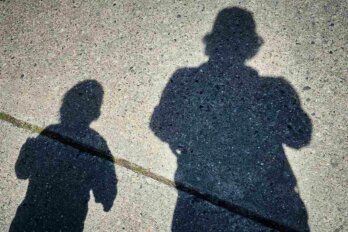For the first time in over a year, I felt like a normal human being. I sat at one of four desks pushed together in a square learning formation with my notebook open, pencil sharpened, and a variety of coloured pens. During the summer weeks, the numbers in our Toronto class had dwindled to seven people cramming the fundamentals of a new language.
I remember one of my classmates, a parole officer, holding us accountable with eye rolls for incomplete homework and unexplained truancy. My practice partner was a man in his late fifties who lived by the tenets of Jimmy Buffett. There was also a plainclothes priest, a lawyer, and two businesspeople whom I found interchangeable. I was the creative one. Together, we looked nothing like the vibrant, clean-cut models in the subway ads for the Spanish Centre. We knew very little of one another’s backstories apart from our career archetypes, and this anonymity was the key ingredient to my learning experience.
As our time together ticked down, I feared any last-minute attempts by my classmates to bond. I thought, Please don’t ask me a personal question in English.
Yes, I was the writer and the comedian, but I was also emotionally frail and barely holding myself together. I’d experienced a mid-life unravelling timed with two back-to-back sudden deaths. My common-law ex-husband, Matt, died due to injuries sustained in an apartment fire, and five months later, my lover and would-be fiancé, David, died by suicide. In both tragedies, I was central to their end-of-life moments and the aftermath of death work that followed. Both left me reeling from the impact. I was in the trenches of adulthood, going from hospital to funeral home to memorial, navigating not only my grief and trauma but the responses of others.
I wore the social stain of grief. I felt that my sorrow was visible to everyone, that I was as physically identifiable as an engineering student dyed purple during frosh week. I felt a constant pressure to explain the invisible dunce cap of sadness that I wore. But my deeply visceral experience was incommunicable, its overwhelming entirety not a tip-of-the-teeth anecdote but a swollen tongue sliding back against my windpipe. I couldn’t find the words.
In Spanish, I couldn’t speak to the complexity of my traumas or the horrors I’d witnessed. I couldn’t get into the ambiguity of my queer relationships. I couldn’t confess that I felt like I was running for my life and at every turn lurked death and catastrophe. I couldn’t explain the panic of answering phone calls, of opening emails or even envelopes; or why I stopped driving; or why I craved cigarettes even though I’d never smoked before. I couldn’t express that I would fall asleep in my bed in Toronto and wake up disoriented and panicked, thinking I was in Montreal, New York, San Francisco, Saint John, Los Angeles, or any of the places I’d recently travelled to. That I felt ripped open and susceptible, my body a field of landmines. In Spanish, I didn’t know the words: ashes, suicide, life-support, trauma, or survivor’s guilt.
Unable to weave between different tenses, I confronted my present reality. To the questions: What is your career? Are you married? Do you have a pet? I would answer: “Soy escritor. No, soy soltero. Si, yo tengo una gata.” Speaking of my pet, I couldn’t explain how the beloved cat had come back into my custody when Matt died. I was forced to speak small, to relearn the basics, and by investigating a new language, I remembered how to learn. I practised the core skillset for adapting, for navigating change, in preparation to build a life of meaning without my loved ones.
In June 2019, two months after David took his own life, I sat crumpled in my family doctor’s office. I was experiencing episodic flashbacks, looping back in time to particularly intense moments. I could feel, hear, smell, and taste memories rehappening to me. Without warning, I was transported back to Oakland, California, in a heated lovers’ spat with David hours before he ended his life, or to a Sunnybrook Hospital room with Matt as he took his last breath. I hadn’t told my doctor that I’d smashed the front end of my carshare while doing errands or that I’d had a mid-air meltdown while flying home from David’s memorial. Both embarrassments had resulted from involuntary time travel, my term for being yanked backward to relive the worst moments of my life. It didn’t matter if I was idling at a red light, cruising 35,000 feet above Colorado, or sipping a coffee.
The intensity of my grief was measured by how slowly I experienced time. As the world clipped by at its unforgiving pace, I felt like I was on the side of the road, watching. I couldn’t safely merge and join the flow of everyday demands. There were no on-ramps, and the sense of hopelessness was exhausting. While inhabiting this space, the curtain between memories and the present moment could retract immediately. A beep, a whiff of sandalwood, or the shock of a bus rolling over a city pothole would cause numbing in my lips, a burning patch on my left ribs, and tingling on my right wrist. These were the evocative cues and sensations that reopened my unresolved trauma.
“Are you going to kill yourself?” my doctor gently asked.
“No,” I said, honestly, before disintegrating into tears. “But am I losing my mind?”
Artists romanticize mental illness. It’s how we stay mindful of the margins we traverse, how we prepare for the consequences of trading stability for creativity. But, in all my what-ifs, I had never imagined that I would begin to lose my sense of self, my relationship to both time and words. I thought I’d suffered a mild stroke. I couldn’t remember the names of everyday objects, and I lost entire volumes of my vocabulary. The feeling of being speechless is one of asphyxiation, of being buried alive. I became a comedian without timing, a writer without words to describe my hellscape.
Grief is a master mimic. Memory loss, which can feel like aphasia (speech loss caused by something like a traumatic brain injury), can be the limbic system, or “lizard brain,” in survival mode. Sadness, which can feel like depression, could just be stress. Flashbacks, which we culturally clock as PTSD, may resolve with therapy before becoming a chronic disorder. It takes time—months, even years—for your brain to adjust to a new normal and for professionals to discern what is heartbreak and what is a diagnosable disorder.
My doctor and I were delicately laying the groundwork in case of future urgent care. I was already working with a therapist weekly and managing minute-by-minute. Still, statistically, as with many who have experienced spousal death, I knew I was at increased risk of having a reason to be admitted to an emergency room or having a chronic illness diagnosed following my bereavement. A short questionnaire labelled me as having “adjustment issues.” This result came with a prescription bottle of clonazepam, a benzodiazepine used to manage acute panic disorders. I understood I was in precarious territory as I signed a pharmaceutical risk and liability waiver.
While travelling home from the pharmacy, I saw the ads for the Spanish Centre (the high-key staged classroom photos that have decorated Toronto’s subway cars for years). I stared at the models in the picture, clad in colourful sweaters and cotton-twill pants, and wanted to feel their mid-learning laughter. But it was the benzos rattling in my pocket and the dread of dependency that moved me to take action, any positive step forward. I interrupted my commute, got off at Yonge and Bloor, and marched toward the nearby school. I handed over my credit card to the receptionist and declared, “I need to learn Spanish!”
Though I didn’t know it at the time, my impulsive decision to enrol would lead to a makeshift rehabilitation program for both my language and memory functions. Two days later, I dragged my grieving, time-travelling ass out of bed to make the class’s 9:30 a.m. start time.
By July, I had settled into part-time student life, carving out study time and labelling objects in my apartment with translated nouns. I found a temporary structure, a reason to get out of bed, and a place to be social.
Thanks to la profesora, our upbeat teacher, I remember us becoming a cohesive group that could count to 100, describe our outfits, and ask for the bill at an imaginary restaurant. I was not the star student; I was downright terrible—even with fifty cue cards of conjugated regular and irregular verbs laid out in front of me. I struggled with shaping the simple n sound and without fail substituted on the nasal en sound gleaned from an Ontario education in French. But I found myself falling in love with Spanish and its directness. I loved the permission to exaggerate with rolling r’s, enunciate using Cheshire Cat grins, and invert punctuation to add emphasis at the beginning of a question or exclamation. I even made a list of random words that felt like magic to speak: inodoro (toilet), quieres (you want), julio (July), trabajo (work). The roughly translated worksheet phrase un hombre solamente italiano (a man who is only Italian) became a running joke in our group. “¡Yo quiero un hombre solamente italiano!” was my go-to reply when I didn’t know how to answer during drill rounds.
By connecting “uno, dos, tres,” to “one, two, three” and “rojo, amarillo, azul” to “red, yellow, blue,” I reinforced my English foundation. A 2008 case study by University of California, Los Angeles academic Monika Połczyńska-Fiszer focused on second-language acquisition as a method for rehabilitation following a traumatic brain injury. As Połczyńska-Fiszer explained, “Learning a foreign language is a highly complex cognitive linguistic process which relies heavily upon nearly all cognitive functions, especially linguistic skills, executive functions and motivation, working memory, episodic memory and semantic memory.” As the burden to communicate what happened to me eased, my brain fog dissipated and my sorrow coagulated.
I found myself laughing in a group of strangers struggling to share the most superficial details of our lives, like the colours of our clothes or hair, our favourite TV shows or foods. Halfway through my experience, I realized that everyone in the class was probably faking it, which was okay: sometimes faking it is an essential learning strategy. Outside the classroom, I was gifted a temporary identity—I could fake it with friends or colleagues, who didn’t have to tiptoe around my unexpected Spanish-learning adventure. We had something to talk about other than my grief, and I could regulate death and dying away from the forefront of my living relationships.
During the last of our twelve sessions, we reviewed the key learnings of beginner-level Spanish while snacking on bran muffins made by the parole officer. A rapid-fire series of questions and lagging answers met with cheers, groans, and forehead slaps proved a wholesome and fibre-filled way to wrap up our time together.
“Okay, Shawn,” said la profesora, holding up a particleboard analog clock. “¿Qué hora es?”
I read the face of the well-worn teaching aid: the tiny hand hovered between three and four, and the large hand dangled at six. Obviously, it was 3:30. To tell the time is a pedestrian task until you have to do it in a language you’ve just learned, remembering the rules for communicating quarter-past, half-past, quarter-to. Even though we had spent weeks drilling the rules of time, I looked to my classmates in a panic. They nodded back with can-do encouragement.
“Son las tres y media,” I answered, nodding my head between each word.
“¡Si!” la profesora exclaimed with genuine enthusiasm. “¡Son las tres y media!”
As a comedian struggling with interruptive flashbacks, the humour of being drilled on the time and date did not go unnoticed. The beauty of attempting to learn a new language is that you discover unexpected, somewhat romantic footholds to ground you in the unknown. For instance, the difference between when to say “good morning,” “good evening,” or “good night” is an embodied decision. Spanish squeezes every second of daylight to delineate between tardes (afternoon) and noche (night). There is much cheekiness in greeting “buenas noches” instead of “buenos días” to someone stumbling home to bed in the early morning light. In this way, time feels immediate, almost emotional.
As we said goodbye, I recall la profesora packing her teaching materials, slipping our sealed feedback sheets into a manilla envelope, and balancing two muffins on top of her belongings. “Para mis hijos,” she explained. I smiled, learning she had kids—two, I assumed based on the muffin count—and because I understood what she had said without having to mentally translate it into English.
It was an awkward, understated farewell, with no promises to keep in touch as we filed out into the hallway—a perfect ending for me. Learning Spanish wasn’t a panacea but the first step in my long recovery. Even as my flashbacks deepened and my therapy sessions doubled, a curiosity to explore language grew inside me. I needed to reestablish where my physical self ended and the outside world began; I needed to study a patchwork of languages and begin to speak from that centred place. Learning a new language, even badly, gave me a new and gentler relationship to time, language, and myself.
“Okay, chicos!” la profesora called out. “¡Mañana, mañana!”
“¡Mañana, mañana!” we responded.
If you or someone you know is having a suicide crisis, please call the Canada Suicide Prevention Service (1-833-456-4566), which offers 24/7 support. There is also Kids Help Phone (1-800-668-6868), the First Nations and Inuit Hope for Wellness Help Line (1-855-242-3310), and 1-866-APPELLE (for Quebec residents).





